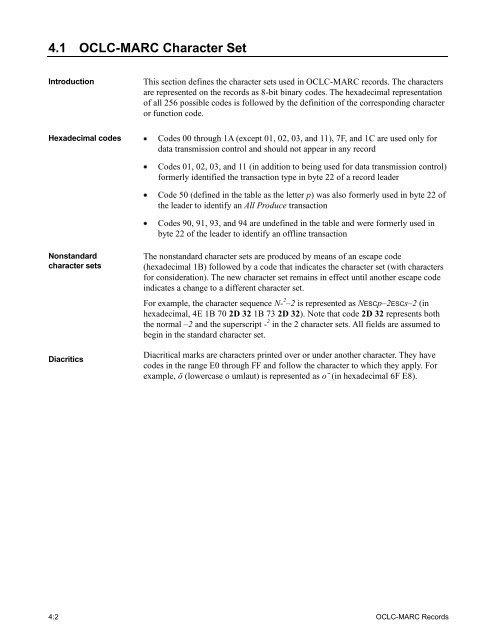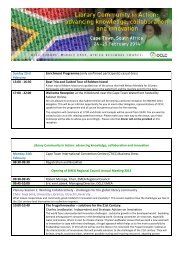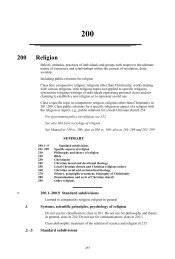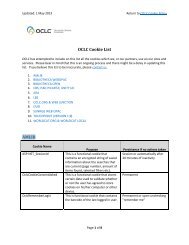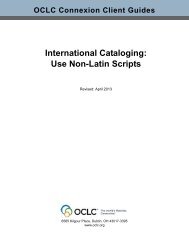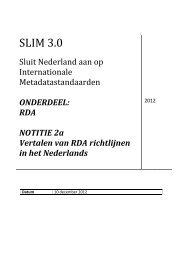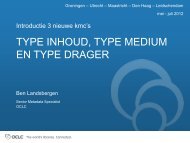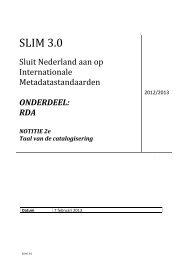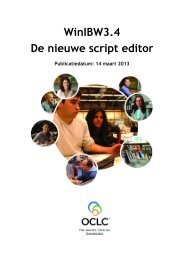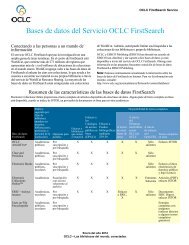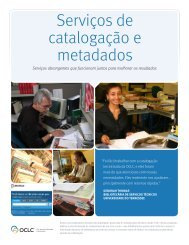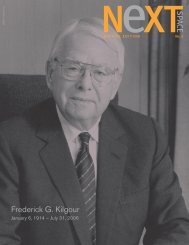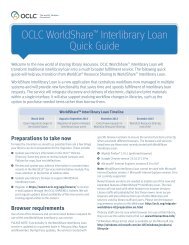4. Character Sets - OCLC
4. Character Sets - OCLC
4. Character Sets - OCLC
Create successful ePaper yourself
Turn your PDF publications into a flip-book with our unique Google optimized e-Paper software.
<strong>4.</strong>1 <strong>OCLC</strong>-MARC <strong>Character</strong> Set<br />
Introduction<br />
Hexadecimal codes<br />
Nonstandard<br />
character sets<br />
Diacritics<br />
This section defines the character sets used in <strong>OCLC</strong>-MARC records. The characters<br />
are represented on the records as 8-bit binary codes. The hexadecimal representation<br />
of all 256 possible codes is followed by the definition of the corresponding character<br />
or function code.<br />
Codes 00 through 1A (except 01, 02, 03, and 11), 7F, and 1C are used only for<br />
data transmission control and should not appear in any record<br />
Codes 01, 02, 03, and 11 (in addition to being used for data transmission control)<br />
formerly identified the transaction type in byte 22 of a record leader<br />
Code 50 (defined in the table as the letter p) was also formerly used in byte 22 of<br />
the leader to identify an All Produce transaction<br />
Codes 90, 91, 93, and 94 are undefined in the table and were formerly used in<br />
byte 22 of the leader to identify an offline transaction<br />
The nonstandard character sets are produced by means of an escape code<br />
(hexadecimal 1B) followed by a code that indicates the character set (with characters<br />
for consideration). The new character set remains in effect until another escape code<br />
indicates a change to a different character set.<br />
For example, the character sequence N- 2 –2 is represented as NESCp–2ESCs–2 (in<br />
hexadecimal, 4E 1B 70 2D 32 1B 73 2D 32). Note that code 2D 32 represents both<br />
the normal –2 and the superscript - 2 in the 2 character sets. All fields are assumed to<br />
begin in the standard character set.<br />
Diacritical marks are characters printed over or under another character. They have<br />
codes in the range E0 through FF and follow the character to which they apply. For<br />
example, ö (lowercase o umlaut) is represented as o¨ (in hexadecimal 6F E8).<br />
4:2 <strong>OCLC</strong>-MARC Records


